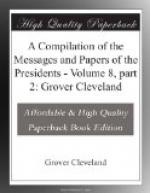It shall, however, be lawful for either party to annex to its respective first statement, for the purposes of general illustration, any of the maps, surveys, or topographical delineations which were filed with the commissioners under the fifth article of the treaty of Ghent, any engraved map heretofore published, and also a transcript of the above-mentioned Map A or of a section thereof, in which transcript each party may lay down the highlands or other features of the country as it shall think fit, the water courses and the boundary lines as claimed by each party remaining as laid down in the said Map A. But this transcript, as well as all the other maps, surveys, or topographical delineations, other than the Map A and Mitchell’s map, intended to be thus annexed by either party to the respective statements, shall be communicated to the other party, in the same manner as aforesaid, within nine months after the exchange of the ratifications of this convention, and shall be subject to such objections and observations as the other contracting party may deem it expedient to make thereto, and shall annex to his first statement, either in the margin of such transcript, map or maps, or otherwise.
Note X.
[Extract from the award of the King of the Netherlands.]
Considering that, according to the instances alleged, the term highlands applies not only to a hilly or elevated country, but also to land which, without being hilly, divides waters flowing in different directions, and that thus the character, more or less hilly and elevated, of the country through which are drawn the two lines respectively claimed at the north and at the south of the river St. John can not form the basis of a choice between them.
Note XI.
The reason of the double delineation of the Restigouche on the map of Mitchell and several others of ancient date is obvious. A mistake was common to them all by which the Bay of Chaleurs was laid down too far to the north. The main branch, or Grande Fourche, of Restigouche (Katawamkedgwick) has been reached by parties setting out from the banks of the St. Lawrence at Metis, and was known to fall into the Bay of Chaleurs, while the united stream had also been visited by persons crossing the wagansis of Grand River and descending the Southwestern Branch. The map makers could not, in consequence of the error in latitude, make their plat meet, and therefore considered the part of the united streams reached in the two different directions as different bodies of water, and without authority sought an outlet for that which they laid down as the southernmost of the two in another bay of the Gulf of St. Lawrence. On many of the maps, however, the small stream which modern geographers improperly call Restigouche is readily distinguishable under the name of Chacodi.
Note XII.
In the argument of the British commissioners under Jay’s treaty the following points were maintained, and, being sanctioned by the decision of the umpire, became the grounds of an award acceded to by both Governments:




